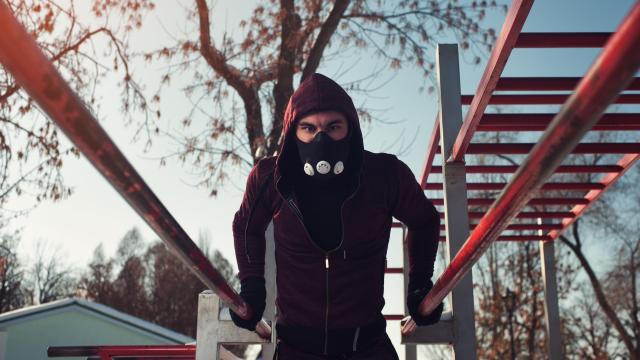The thin air at high altitudes has long been recognised as a training superpower for athletes. If you live and train at altitude, you’ll likely wipe the floor with your lowland competitors. That’s why elite runners will often move to a mountain town, temporarily or permanently, to get some of those sweet altitude adaptations. Wouldn’t it be great if you could do the same thing without having to hop on a plane?
That’s the idea behind altitude training masks. Strap one on for a gym session, the idea goes, and you’ll train your body to do more work on less oxygen. But do they work? Unfortunately, no.
Altitude training isn’t just about training time
The benefits of altitude on training come from living at altitude, not training there. Even if you could teleport to Boulder every time you wanted to go for a jog, you wouldn’t get those high-altitude adaptations. Altitude “training” requires at least 12 hours of your day spent in air with a low partial pressure of oxygen.
When the air you breathe has less oxygen, per breath, than you’re used to, your body takes action. A hormone called erythropoietin (EPO for short) responds to this by telling your body to make more red blood cells. This doesn’t happen if you’re only short on oxygen for a brief time during workouts. In fact, athletes who move to high-altitude training locations often commute to a lower elevation for workouts. This lets them get the benefits of living at altitude while still having a rich supply of oxygen during their workouts.
Masks don’t really mimic altitude
If you strap on a mask for your workouts, you’re actually doing the opposite of what athletes do: You’re breathing a normal amount of oxygen all day long, then restricting it just when you need it most. You don’t get the EPO boost and you’re making your workouts harder for, essentially, no reason.
There’s another reason why masks don’t really mimic altitude: Restricting the amount of air you breathe is not the same thing as lowering the pressure of the air. You’re still getting sea-level air, you just have to work harder to suck it in. Studies like this one show that training in a mask doesn’t improve your fitness over training without one.
How to improve your cardio fitness
If you want to be less out of breath when you exercise, what you really want is to improve your cardio fitness. And the way to do that is by getting lots of cardio at a mix of intensities
Low intensity cardio builds adaptations that help your body take in and use more oxygen. High intensity cardio (like true HIIT) pushes your body to make different adaptations, and training right in the middle — at what’s sometimes called your lactate threshold — has its own benefits, as well. Endurance athletes do a mix of all these types. (We have more on the benefits of different zones of cardio here.)
This means that when you’re doing your cardio workouts, you want to be able to take in plenty of oxygen so your body can do the workout you’re asking it to do. If you’re lifting instead, oxygen intake is even less important, since you don’t need much oxygen during your lifts, only to recover in between those short efforts.

Leave a Reply
You must be logged in to post a comment.